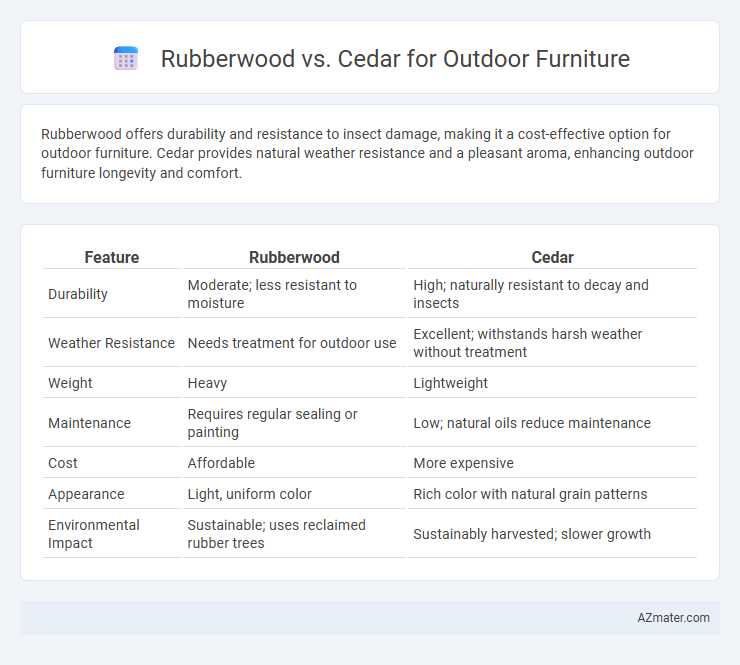Rubberwood offers durability and resistance to insect damage, making it a cost-effective option for outdoor furniture. Cedar provides natural weather resistance and a pleasant aroma, enhancing outdoor furniture longevity and comfort.
Table of Comparison
| Feature | Rubberwood | Cedar |
|---|---|---|
| Durability | Moderate; less resistant to moisture | High; naturally resistant to decay and insects |
| Weather Resistance | Needs treatment for outdoor use | Excellent; withstands harsh weather without treatment |
| Weight | Heavy | Lightweight |
| Maintenance | Requires regular sealing or painting | Low; natural oils reduce maintenance |
| Cost | Affordable | More expensive |
| Appearance | Light, uniform color | Rich color with natural grain patterns |
| Environmental Impact | Sustainable; uses reclaimed rubber trees | Sustainably harvested; slower growth |
Introduction: Rubberwood vs Cedar for Outdoor Furniture
Rubberwood and cedar are popular choices for outdoor furniture due to their durability and aesthetic appeal. Rubberwood is prized for its strength, resistance to warping, and eco-friendly qualities as a byproduct of rubber plantations. Cedar offers natural resistance to moisture, decay, and insect damage, making it a reliable option for outdoor environments.
Material Overview: What is Rubberwood?
Rubberwood is a sustainable hardwood derived from the Para rubber tree (Hevea brasiliensis) once its latex-yielding cycle ends, making it an eco-friendly option for outdoor furniture. It features a pale, light color with a medium density that offers moderate durability and resistance to decay when properly treated with sealants or finishes. Compared to cedar, rubberwood requires thorough weatherproofing to withstand outdoor elements but provides a cost-effective and stable material choice with a fine grain texture ideal for furniture crafting.
Material Overview: What is Cedar?
Cedar is a softwood known for its natural resistance to decay, insects, and moisture, making it a popular choice for outdoor furniture. It has a distinctive aromatic scent due to natural oils that act as preservatives, enhancing its durability and preventing rot. Cedar wood features a fine, straight grain with a reddish hue that weathers to a silvery gray, offering both aesthetic appeal and long-lasting performance in outdoor environments.
Durability and Weather Resistance Comparison
Rubberwood offers moderate durability and is treated to resist moisture, making it suitable for outdoor furniture in mild climates but less effective under prolonged exposure to harsh weather. Cedar is naturally resistant to rot, decay, and insect damage, ensuring superior weather resistance and long-lasting durability in various outdoor conditions. Comparing both, cedar outperforms rubberwood in durability and ability to withstand rain, humidity, and temperature fluctuations without significant deterioration.
Maintenance Requirements: Rubberwood vs Cedar
Rubberwood requires regular sealing and protective coatings to prevent moisture absorption and insect damage, ensuring its durability in outdoor conditions. Cedar naturally resists decay, insects, and moisture, reducing the need for frequent maintenance but benefits from occasional oiling to maintain its weather resistance and rich color. Choosing between rubberwood and cedar depends on the desired balance between routine upkeep and natural resilience for outdoor furniture longevity.
Eco-Friendliness and Sustainability
Rubberwood, sourced from the parenchyma cells of Hevea brasiliensis trees after latex extraction, is highly eco-friendly due to its use of plantation timber that would otherwise be discarded. Cedar, known for its natural resistance to decay and pests, offers durability without chemical treatments, contributing to sustainability in outdoor furniture. Both woods provide renewable options, but rubberwood excels by repurposing waste material, reducing deforestation pressure and promoting a circular wood economy.
Aesthetic Appeal and Design Options
Rubberwood offers a smooth, light-colored finish that complements modern and minimalist outdoor furniture designs, providing a clean and uniform aesthetic. Cedar features rich, warm tones with natural grain patterns that enhance rustic and traditional outdoor settings, adding character and visual depth. Both woods are versatile, but Rubberwood's consistent texture suits painted or stained finishes, while Cedar's natural oils protect and showcase its vibrant hues without additional treatment.
Cost and Budget Considerations
Rubberwood offers a cost-effective solution for outdoor furniture due to its widespread availability and efficient manufacturing process, making it ideal for budget-conscious buyers. Cedar wood typically comes at a higher price point, reflecting its natural resistance to moisture, decay, and insect damage, which can reduce long-term maintenance expenses. Choosing between Rubberwood and Cedar hinges on balancing upfront costs with durability needs and maintenance budget.
Pros and Cons of Rubberwood for Outdoor Use
Rubberwood offers durability and resistance to warping, making it a cost-effective option for outdoor furniture, but its susceptibility to moisture damage and fungal decay without proper treatment limits its longevity in harsh weather conditions. It is an eco-friendly choice, sourced from rubber trees that have finished latex production, contributing to sustainable forestry practices. Proper sealing and regular maintenance are essential to enhance rubberwood's weather resistance and prevent deterioration when used outdoors.
Pros and Cons of Cedar for Outdoor Use
Cedar offers excellent natural resistance to moisture, decay, and insect damage, making it ideal for outdoor furniture exposed to varying weather conditions. Its aromatic oils provide a fragrant smell that also acts as a natural preservative but can sometimes cause skin irritation in sensitive individuals. However, cedar requires periodic maintenance, such as sealing or staining, to preserve its color and durability over time against UV rays and harsh elements.

Infographic: Rubberwood vs Cedar for Outdoor Furniture
 azmater.com
azmater.com